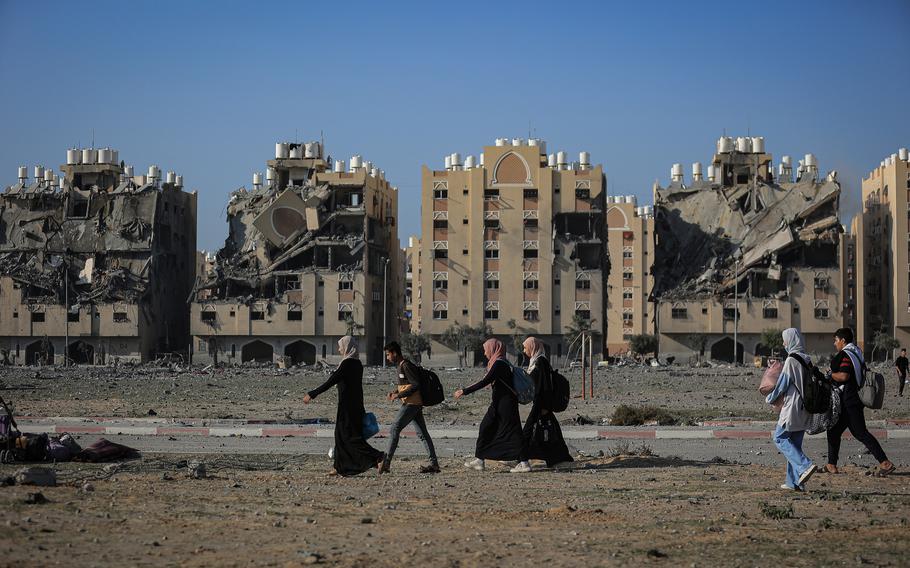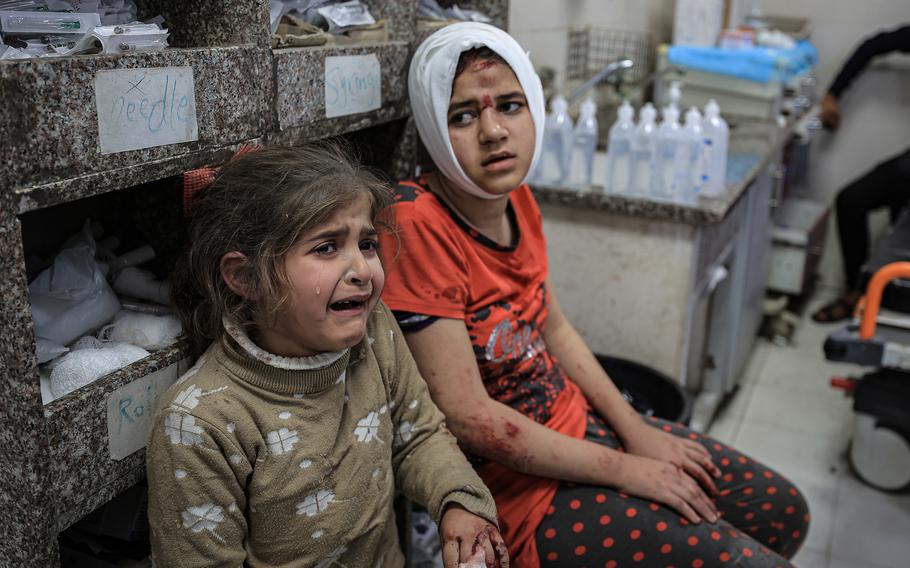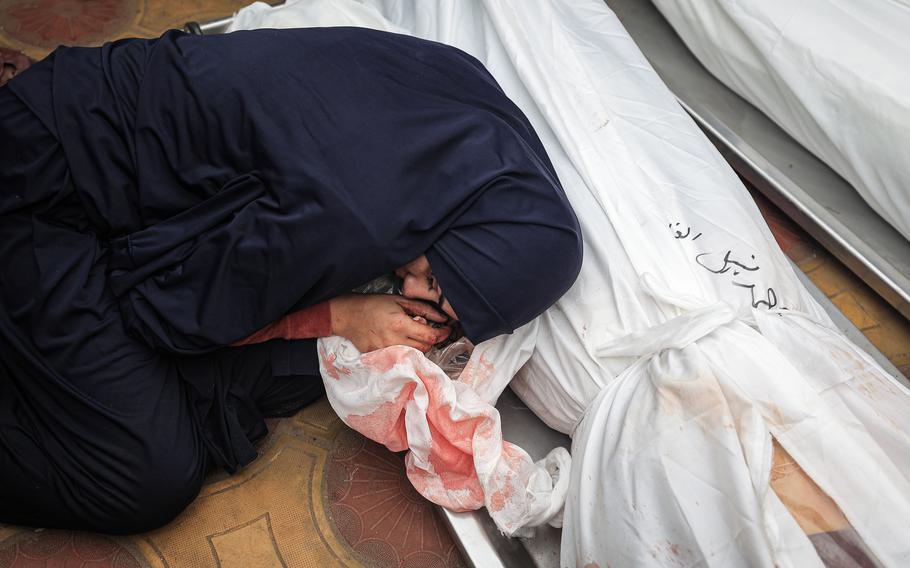Middle East
Israel touts civilian warning system, but for Gazans, nowhere is safe
The Washington Post December 6, 2023

Residents leave the Hamad Towers area after Israeli attacks in Khan Younis on Saturday, Dec. 2, 2023. (Loay Ayyoub/for The Washington Post)
BEERSHEBA, Israel — On a military base in the center of this biblical desert city, Israeli officials sit in a small control room lined with maps and monitors, charged with directing the movement of panicked civilians in war-ravaged Gaza.
On Monday, beneath a digital diagram of the Strip, data analysts, lawyers and Arabic translators surrounded an army officer. He had phone numbers for military leaders, tank commanders and tens of thousands of civilians in Gaza, including in the southern city of Khan Younis, where Israeli bombs rained down and ground forces will later enter.
The color-coded map purported to show where more than 2 million Gazans, 80% of them displaced, were sheltering. Using airdropped leaflets, calls and texts, and informed by knowledge of battle plans, these technicians tell desperate families where they should go next. The Israel Defense Forces points to the system as proof that it is fulfilling its obligation under international law to minimize civilian casualties.
“It is one of the smartest rooms in the IDF,” said an Israeli official, who spoke on the condition of anonymity to discuss the details of the evacuation system.
But the experiences of civilians in Gaza reveal the limits of these efforts, as Israel presses forward with an all-out war against militants in a densely packed enclave with no escape, which humanitarian leaders have likened to “hell on earth.” The Gaza Health Ministry says nearly 16,000 people, the majority of them women and children, have been killed since Israel launched its attacks two months ago in retaliation for the Hamas rampage on Oct. 7.
Gazans reached by The Washington Post say Israel’s high-tech system has been no match for the brutal reality of its military campaign. In the chaos of combat, the Israeli directives are confusing, vague or contradictory, they said, often sending them from one battlefield to another.
Muhammad al-Natour fled his Gaza City home in October after Israel ordered more than a million people in the north to move south. At the time, the IDF described Gaza’s southern half as a “safe zone.” The language changed to “safer zone” in November.
Nowhere offered a reprieve from bombardment.
On Saturday, as tanks neared Khan Younis in the south and airstrikes pounded the region, Natour fled again, evacuating his family from the crowded shelter where they had taken refuge. It was “terrifying,” he said.
After a warning phone call and leaflets from the IDF, Natour moved his mother, who suffers from lung disease, and 24 relatives farther south, to Rafah. If he can’t keep finding her oxygen cylinders, he said, “my mother will die — not because of the bombing but because I failed to provide her with the oxygen she needs to survive.”
Alaa Rajab, 34, who has no access to internet and only intermittent phone service told The Post he hasn’t received any calls or leaflets in recent days advising him how to stay ahead of the danger.
Rajab used to get calls from the IDF at his home in Gaza City before leaving for the south with his wife and three children and settling in the Hamad Towers in Khan Younis. On Saturday, airstrikes hit the complex. The family fled again, to a nearby shelter.
“If they storm Khan Younis, we will leave,” he said. “We don’t know where yet.”
The Israeli tech now includes a downloadable version of an interactive map, dividing Gaza into 623 zones. IDF leaflets now bear a QR code, which can be used to access the latest information about a particular area. Both require internet access, a rare luxury for most Gazans.
On Monday evening, a near-total communications blackout hit the Strip, the latest in a series of outages caused by damaged infrastructure. Limited services returned Tuesday, though few have electricity to charge their phones.
In the interim, the IDF’s guidance for some areas of eastern Khan Younis had changed. IDF leaflets dropped on the area Monday told people to flee for Rafah, calling Khan Younis “a dangerous combat zone.” On Tuesday, new leaflets instead told people to “stay inside known shelters and schools,” warning of a “heavy attack” against Hamas.

Injured children at a hospital in Khan Younis, Gaza, on Monday, Dec. 4, 2023. (Loay Ayyoub/for The Washington Post)
The Israeli official contended that the evacuation orders, while traumatic and disruptive, have saved lives. The official said the IDF has killed “something more” than 5,000 Hamas combatants, estimating the overall death toll was around 15,000 — in line with the figures provided by Gaza’s Health Ministry, which Israeli and U.S. officials have sought to discredit during the war as a propaganda arm of Hamas.
By the IDF’s own math, it has killed two civilians for every militant.
“That proportion is more than acceptable compared to other armies facing similar challenges in urban battlefields,” the official said. “It’s not that we are OK with any loss of civilians. But in the end, we have no choice. We didn’t start this war.”
The seven-day humanitarian pause in fighting, which ended Friday, gave Israel’s allies time to voice rising concerns about civilian casualties.
U.S. Defense Secretary Lloyd Austin said Saturday that protecting noncombatants as the war turned south was “both a moral responsibility and a strategic imperative.” Israel risked “a strategic defeat” if its actions drove civilians into the arms of Hamas, he said.
Philippe Lazzarini, head of the U.N. refugee agency in Gaza, said Monday that recent evacuation orders had “created panic, fear and anxiety.”
“No place is safe,” he said in a statement.
Since Friday, 20 percent of Khan Younis, an area sheltering some 50,000 displaced people, has been told to evacuate, according to OCHA, the U.N. humanitarian agency.
But shelters in Rafah, the main destination, are already far over capacity, Lazzarini said. There’s barely food or water. Disease is spreading fast.
Some Gazans told The Post they were directed to travel in areas that were already under fire, or filled with troops. The warnings to move, sometimes broadcast from hovering drones, often use street and neighborhood names unfamiliar to locals. The IDF said it has refined the Arabic in its messaging. The main route the IDF has specified to take is a highway along Gaza’s coast.
Hossam Murad, 39, was struggling Tuesday to decipher a blur of mixed signals after bombs landed near his temporary shelter near Nasser Hospital in Khan Younis. Some IDF instructions to clear the area seemed to contradict the Israeli map showing secure areas and no-go zones.
“Although we received leaflets, they were neither clear nor accurate,” Murad said, “sometimes advising us to leave one area for another, only to be told to leave the new area later.”
The IDF contends it has done more than other Western armies in recent conflicts to steer civilians to the safest places, starting with its early warnings that Gazans should leave the north for shelters in the south.
Before the week-long humanitarian pause, under U.S. pressure, Israel observed a series of hours-long “tactical, localized” daily pauses, allowing residents in the north to evacuate south along the main north-south highway, Salah al-Din. That corridor has been closed.
Now, officials say improvements in the Beersheba operation center will help them do more to protect civilians.
In the operations room — below three screens of high-resolution drone footage of Gaza and one carrying Al Jazeera — the technicians crunched the data that informed their interactive map. Green zones denoted places where up to 75 percent of residents had fled; blue zones, all in the south, showed where up to three times the normal population was sheltering.
Israeli officials said they were keenly aware of the growing calls for restraint from Washington and other allies around the world.
“They say ‘take precautions,’ and we listen to our friends,” Lt. Col. Richard Hecht, an IDF spokesman, said Monday.
But few Israelis — in the military, politics or civilian life — are ready to curtail the fight against Hamas, whatever the human cost. Prime Minister Benjamin Netanyahu said Tuesday that “crushing force” would be deployed. The IDF said its ground operations now ranged from north to south, even in cities once seen as havens for the displaced.
Gazans should pay attention to the warnings they are sent, Hecht said. More evacuations are coming.
Berger reported from Jerusalem. Balousha reported from Amman, Jordan.

A relative mourns Palestinians killed in an Israeli airstrike ahead of their burials in Khan Younis, Gaza, on Tuesday, Dec. 5, 2023. (Loay Ayyoub/for The Washington Post)